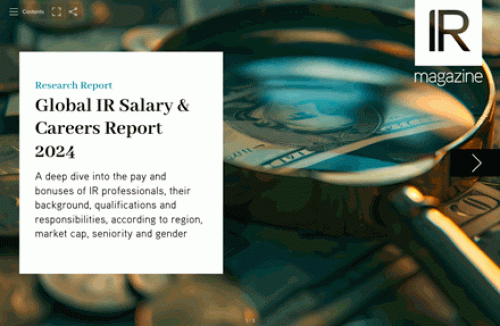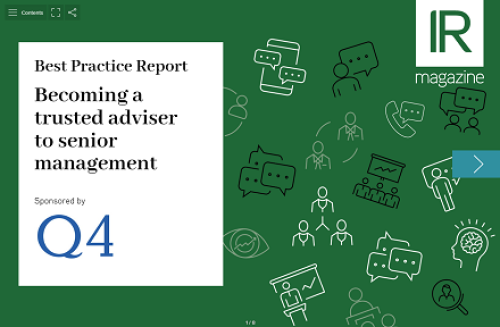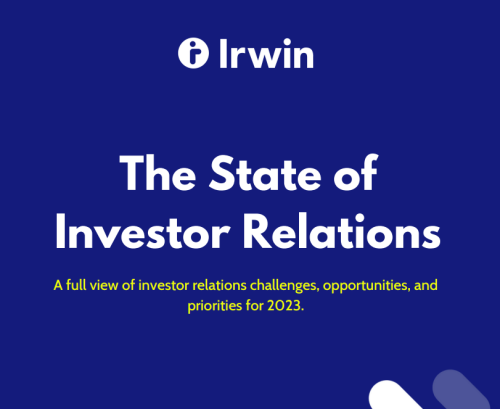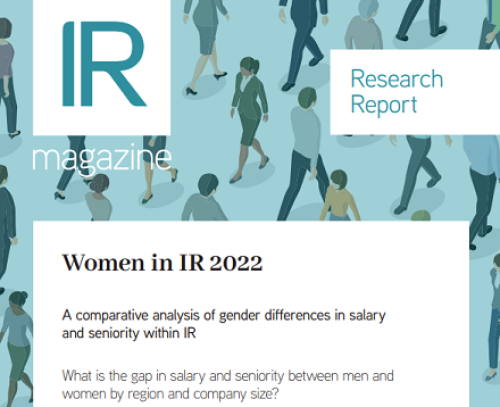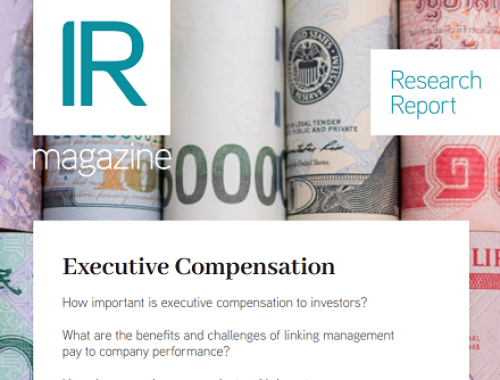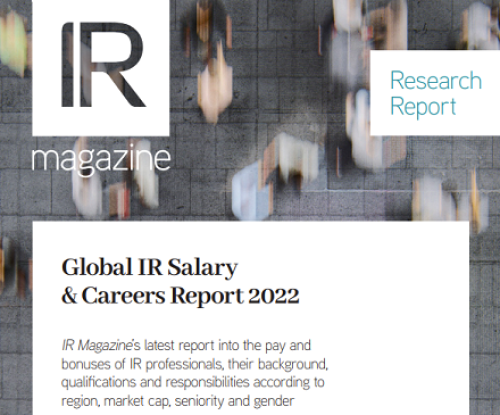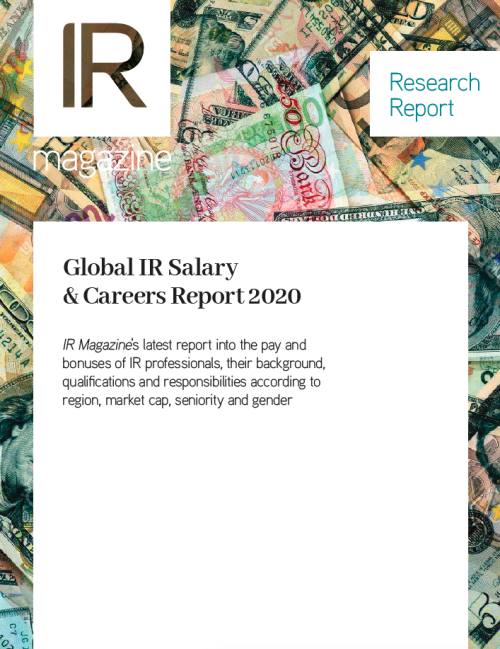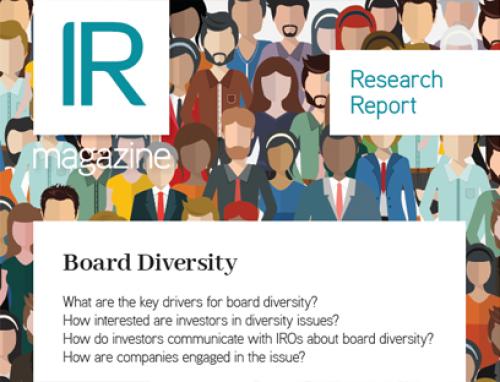Or how IROs with deep company experience took their hits, survived the financial crisis and knocked GE off its pedestal at the IR Magazine US Awards 2009
We called it the GE effect. Almost since the beginning of the IR Magazine US Awards in 1996, one mega-cap company set such a high standard in investor relations that it swept most of the categories. There was no disputing the wisdom of crowds, the votes of thousands of analysts and investors. We found the same phenomenon around the world: the Nokia effect, the TSMC effect, the CN effect and, for many years, the BP effect.
Now introducing: the Wells Fargo effect. The San Francisco-based bank weathered the worldwide financial crisis and finished 2008 with staunch support from more than 2,700 analysts and investors surveyed between November 2008 and January 2009.
At the 14th annual IR Magazine US Awards on March 26 in New York, of the 57 companies nominated for 20 awards, Wells Fargo took home no fewer than five trophies. An investment community still bitter over a bad April 2008 earnings shock clobbered GE right out of the running.
This year’s grand prix list confirms that these awards recognize transparency, responsiveness and access, not stock market razzle-dazzle. Wells Fargo didn’t win despite being a bank in the middle of the financial crisis; it won because it is a bank maintaining transparency and accessibility under tough conditions.
‘Wells Fargo is to be commended for being straightforward in expressing its subprime exposure and providing a clear, concise, consistent and realistic message throughout the crisis,’ as one survey respondent said.
In the face of adversity
‘As we all know, 2008 was a challenging year in the economy and an unprecedented year for the financial services industry,’ says Bob Strickland, Wells Fargo’s head of IR. ‘In the face of that, we enhanced our efforts by being more responsive to information requests, listening more keenly to our shareholders’ views, thoughts and concerns, and hosting additional investor/analyst calls.’
Survey respondents confirm that Wells Fargo ‘stepped up the quality of its conferences to respond to the changing market conditions.’ Strickland adds that the bank spent more time on investor meetings following the surprise Wachovia merger announcement last fall.
Unusually, Wells Fargo prerecords its earnings calls and doesn’t take Q&A. But analysts and investors don’t seem to mind – perhaps because the payback is personal attention from the IR team. Strickland is known for being an ‘honest, solid individual’ with ‘a track record of being a straight shooter’, and the IR team is praised for its knowledge of both the company and the industry, and for never using Reg FD as ‘an excuse to hide behind’.
Strickland’s IR chops stretch back more than 20 years. In 1979 he joined Norwest Corp in Minneapolis as assistant treasurer and took on IR in 1987. In 1998, when Norwest and Wells Fargo merged, he moved to San Francisco to head up the newly combined bank’s investor relations team.
Deep experience
Comments about Texas Instruments (TI) from analysts and investors reveal a strong undercurrent in this year’s research: the value of experience. The company’s main IR pros – Ron Slaymaker, Dave Pahl and Richard Kerslake (who joined the team in mid-2008) – have more than 20 years’ experience each at the company, from engineering to sales and marketing to running product businesses.
‘Whether it’s strategy or financials or products, analysts and investors are interfacing with people who can answer their questions directly,’ says Slaymaker, who joined TI in 1982 and took on IR in 1998. He shares airtime on the quarterly earnings call with TI’s chief financial officer and handles mid-quarter update calls solo.
TI was also praised for its annual analyst day, which actually lasts for two days. For the last one, held in May 2008, video of every presentation – not just those of the chief executive and CFO – was posted on the web with rolling transcripts. Around 175 investors and analysts came to the event in Dallas; more than 5,000 people from 40 countries viewed the presentations online.
This year, for the first time in a decade, TI is skipping its analyst conference. ‘You’re not going to see less of us,’ Slaymaker emphasizes. ‘We’re going to give the same amount of insight, but we’re going to do it with less overhead.’ For example, TI has been hosting a series of small group meetings with key investors, including ‘special topic’ sessions.
Humana, a health benefits company, came from Louisville, Kentucky with a team of nine including CEO Mike McCallister to pick up its grand prix and best IRO award.
That was appropriate considering that access to a range of Humana executives was a factor in the voting. ‘While a lot of larger firms introduce investors to only three or four individuals, Humana involves probably a dozen of its people,’ said one survey respondent. ‘Senior management members aren’t fearful of letting others in their organization speak with investors, which is comforting to institutional shareholders.’
Strategic response
A stumble early in 2008 put IR to the test. In late February Humana had to announce a 2009 profit hit because of a technical error in a benefits plan, triggering a huge sell-off in the stock.
Regina Nethery, vice president of IR, recalls a 24-hour window when she couldn’t return calls, but she logged and later returned all of them after the bad news was released. Humana’s CEO and CFO attended an investor conference the next week and embarked on a series of special roadshow meetings. ‘We had shot ourselves in the foot, but we kept the lines of communication open,’ Nethery says.
Like Slaymaker and his team, Nethery has deep experience with her firm. She has been at Humana for 24 years, the first 10 as an outside accountant before moving in-house, and the last nine in IR.
First Horizon National Corporation started 2008 as a mortgage market victim. Several months later, after cutting its dividend, selling its national mortgage business and replacing its CEO, the parent of First Tennessee Bank was winning accolades for its disclosure and accessibility.
‘In a very difficult environment, the company has clearly communicated its goals and expectations and, most importantly, delivered on those promises,’ said one respondent.
One minor tactical move may have made a big difference: in conjunction with its approximately 35-page quarterly earnings supplement, First Horizon started sending out 20 slides with concise bullet points. It was the initiative of IR chief Dave Miller, a 15-year company veteran and former marketing chief for First Tennessee, who adds that face-to-face interaction with investors and analysts increased in 2008 by about 20 percent to 350 distinct meetings.
‘For us it wasn’t just about slapping disclosure on the website; it was about management being willing to look people in the eye,’ Miller explains.
Downsized IR, super-sized job
Nokia has won best investor relations in the US market by a continental European company in 10 of the last 11 years, with the trophies generally carried home by the Finnish company’s US-based IR chief, Bill Seymour.
In January 2009 Seymour was named head of North American sales operations. Matt Shimao, number two on the US IR team since 2007, is now carrying on Nokia’s winning tradition.
Shimao previously worked at Bear Stearns as an equity analyst covering enterprise networking, leaving well before the investment bank’s problems came to light. He also worked in various roles including investor relations at 3Com, building on his background in finance at several Silicon Valley companies and as an accountant at KPMG.
His equity research experience helps the IR team be ‘like a sell-side shop for our management team,’ he remarks. ‘We can tell it what we truly think about what other companies are reporting.’
Last year was a rough one for Nokia, and 2009 is looking no easier. Shimao, commenting before the company’s dismal Q1 earnings announcement, says there has been no change in underlying principles. ‘We are built to communicate openly, often and transparently,’ he says.
The IR team is working to keep up the pace of its outreach program while cutting back on costs. There are no plans to replace Seymour, for example, and Kristian Pullola, the Finland-based global head of investor relations, doubles as treasurer.
In December Nokia moved its well-regarded annual capital markets day from Manhattan to downtown Brooklyn, saving $500,000. Another advantage was that everyone stayed on-site instead of bobbing in and out, and the events team had two days to set up instead of just the night before.
One of the IR team’s goals in 2009 is to implement tools to help it share information internally – a crucial function for a global company. Shimao stresses that the tone of ‘proactive, frequent, transparent, always-there communication’ is set at the top by Rick Simonson, Nokia’s CFO.
Tokyo heart, New York footprint
Sony has had an IR presence in New York since the 1970s, and during the first years of the IR Magazine US Awards it won consistently for best IR in the US market by an Asia-Pacific company. It fell in the rankings from 2004, when it lost to Canon, until last year, when India’s Infosys narrowly took the prize. Sam Levenson joined as head of IR in the US in 2006 and his work since then has helped Sony win back its title.
Levenson is an IR stalwart with long involvement in NIRI and the Investor Relations Association in the US. In 2005, while still head of IR at Cendant, he co-chaired the CFA Institute/NIRI joint task force on issuer-analyst relations. Earlier in his career he handled IR at Staples and Designs.
At Sony, Levenson has looked beyond the traditional Japanese equity holder to institutional investors across the spectrum of the company’s businesses: consumer electronics, mobile phones, games, financial services and entertainment. ‘It would be fair for any potential Sony investor who really wanted to do due diligence to ask questions about any of those businesses,’ he says.
Levenson uses those five peer sets to update his target list every quarter, guiding how often and with whom he meets on his four-times-a-year road trips to every major US market. ‘It’s among the more aggressive targeting programs I’ve seen,’ he adds.
With a New York-based team of five, including two Japanese speakers on loan from Japan, Levenson is in constant communication with 15 IR staff in Tokyo and two in London. Most of the traditional IR and shareholder services, including disclosure filings, proxy preparation and an annual meeting for 7,000 attendees, are handled in Japan, which Levenson visits six to eight times a year.
‘To be successful in this market, you have to have feet on the ground,’ Levenson says of his New York team. ‘But there’s no way we could be successful without the collaborative support of the Tokyo IR team. It is our information source; it’s closest to where strategy is being set and decisions made. That’s where 90 percent of the trading takes place. We’re really an extension of the Tokyo IR team.’
How we picked the winners
A lot was different about this year’s awards event. Black-tie was out, sober business attire in, and IR magazine gave $10,000 from the ticket sales to New York City’s Coalition for the Homeless.
One thing stayed the same, however: the rigorous research. Erdos & Morgan has conducted the investor perception study for the IR Magazine US Awards for the past 10 years. Invitations were sent to the universe of US-based analysts and portfolio managers identified by Thomson Reuters and Ipreo, and 1,392 completed the online survey.
Retail investors, including Barron’s Online subscribers and BetterInvesting members, voted separately for the award for best communications with the retail market; 80,000 were emailed – more than ever before – and 1,346 cast their votes.
The survey took place from November 19, 2008 to January 12, 2009. Respondents were asked to judge investor relations quality, not stock market performance, and companies did not enter themselves. Any listed US company was eligible for the open-ended nominations.
The complete results, including verbatim comments from investors and analysts, are published in IR magazine’s Investor Perception Study, US 2009, sponsored by the Bank of New York Mellon. To order a copy, see www.irmagazineus.com.
IR Magazine US Awards 2009 winners
Grand prix for best overall IR
Mega-cap: Wells Fargo
Large cap: Texas Instruments
Mid-cap: Humana
Small cap: First Horizon National Corporation
Best investor relations officer
Mega-cap: Bob Strickland, Wells Fargo
Large cap: Dave Pahl & Ron Slaymaker, Texas Instruments
Mid-cap: Regina Nethery, Humana
Small cap: David Miller, First Horizon National Corporation
Best investor relations website
Aflac and JPMorgan Chase
Best IR by a chairman or CEO
Rex Tillerson, ExxonMobil
Best M&A investor relations
Wells Fargo & Wachovia
Best corporate governance
Wells Fargo
Best crisis communications
Goldman Sachs
Best corporate advertising
Charles Schwab
Best investor relations by a continental European company in the US market
Nokia
Best investor relations by an Asia-Pacific company in the US market
Sony
Best communications with the retail market
Wells Fargo
Best annual report
Microsoft Corp and the Walt Disney Company
Most progress in IR – small to mid-cap
HealthSouth
Best use of conferencing – small to mid-cap
Continental Airlines
Lifetime achievement in IR
Marty Shea
Note: Market caps are as at December 31, 2008
Mega-cap: over $30 bn
Large cap: $10 bn to $30 bn
Mid-cap: $2.5 bn to $9.9 bn
Small cap: under $2.5 bn
View from the top
ExxonMobil’s Rex Tillerson, winner of best IR by a CEO, sent a message by video:
‘...During these turbulent times, investors everywhere are dealing with uncertainty and concern about their long-term value. At ExxonMobil, for more than 125 years, our principal business objective has been to maintain and create long-term shareholder value, and we work hard to share how we achieve that with our shareholders and potential shareholders: our approach to disciplined investment decision making, our commitment to sound risk management approaches, operational excellence, and always conducting ourselves to the highest ethical standards.’
Marty Shea, who is retiring from his post as IR chief at CBS, was presented with this year’s award for lifetime achievement in IR. Long-time boss Sumner Redstone also appeared on video at the awards ceremony:
‘...Marty, you have had a remarkable career, and have been a tremendous asset to Viacom, to CBS and to me personally – a role that I know you will continue to serve. So Marty, congratulations my friend, and remember: keep your damn phone on!’

